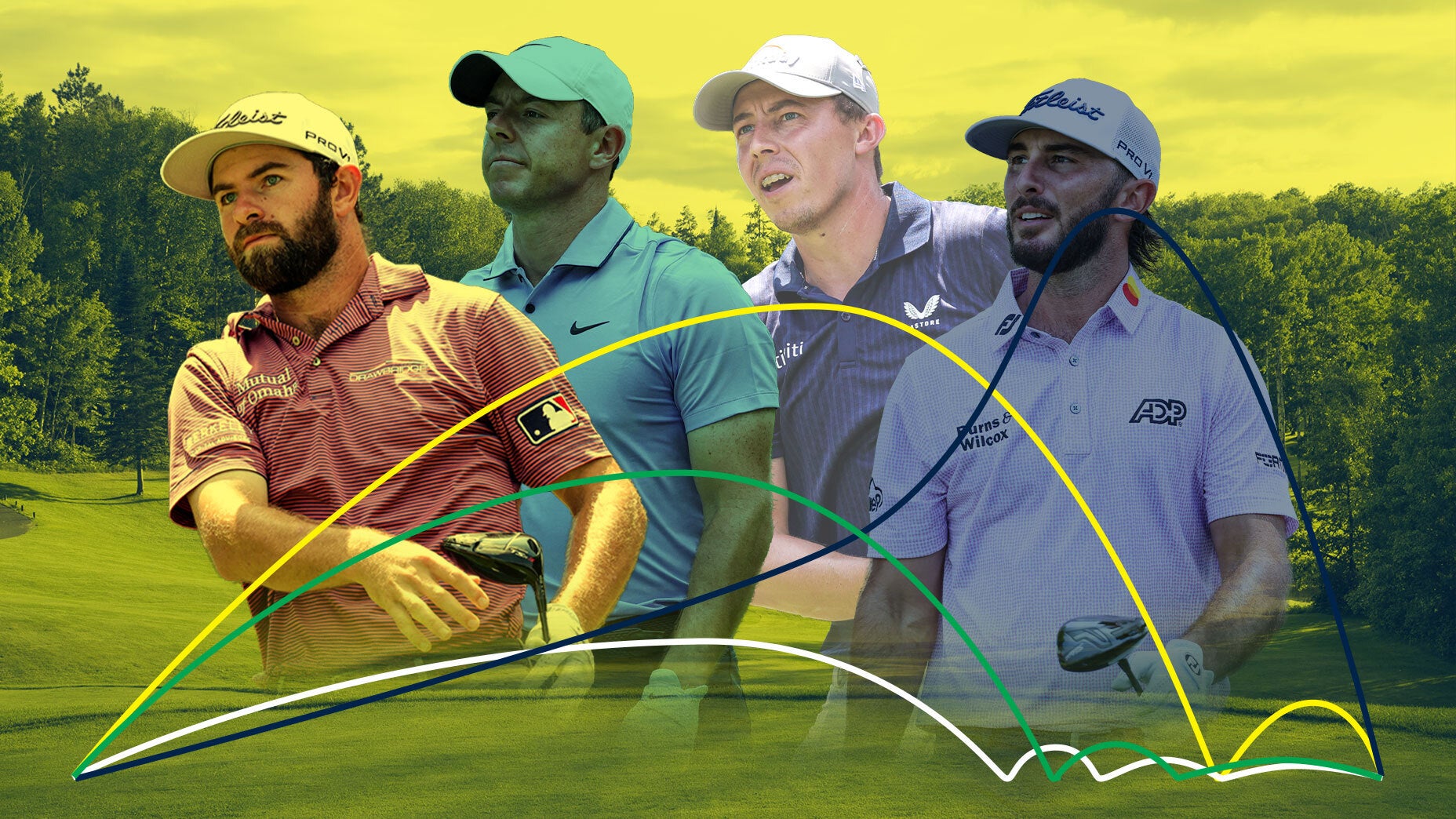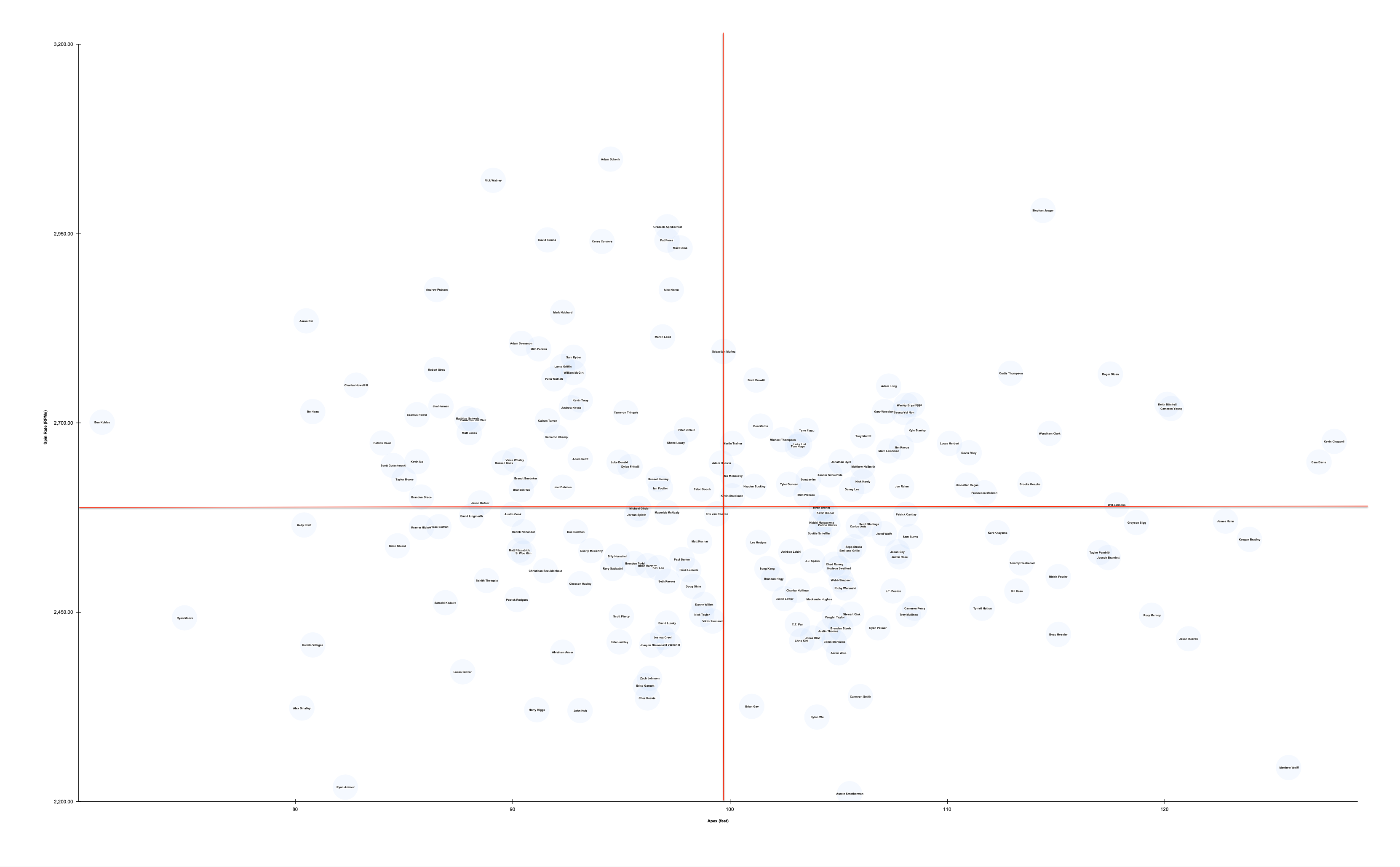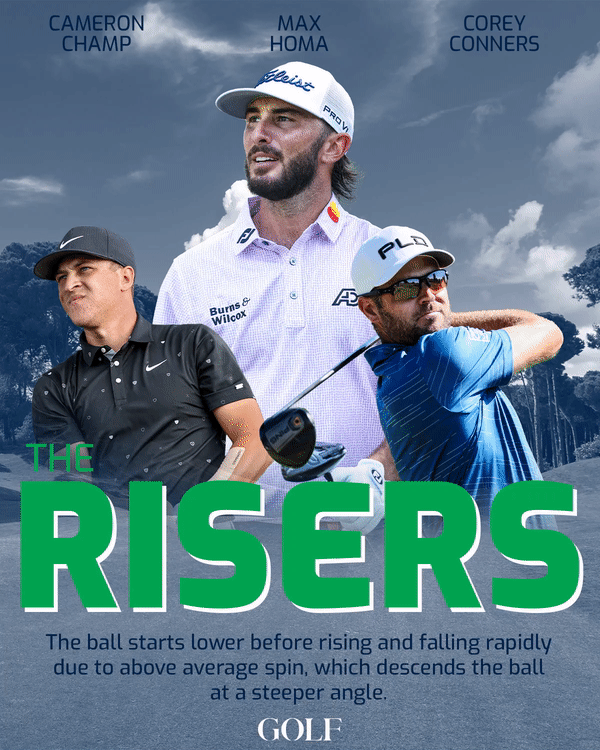How would you describe a golfer’s game to someone who has never seen them play? Or even one who has? Would you use numbers? Words? Rankings?
Whereas in baseball analysts can paint a pitcher’s portrait by describing the tools in his arsenal — he’s got a 95 mph fastball, a filthy change up, a nasty slider, and a 12-6 curveball — golf fans quickly bump into cliches or generalities to describe the very best who play it. That’s a shame for a game as colorful and complex as golf, which can be played well in so many different subtle ways.
But the good news is the PGA Tour has the tools for us to change it.
Each drive players hit on par 4s and 5s is tracked by ShotLink. Not just where the shot ended, but the exact way it was hit to get there. Its height, its speed, its yardage. Zoom out over the course of a PGA Tour season and you have a clearer understanding of how each golfer plays the game.

Of course, PGA Tour golfers don’t get to the highest level being pure specialists who drive the ball the same way every time. In different circumstances, golfers will choose different shots, defying simple categorization. Golfers who naturally hit the ball higher can fire a low stinger when needed, just as a low-ball hitter can float one into the air if required.
But over the course of hundreds of tee shots, tracked over the course of an entire season, on par 4s and 5s of every shape and length, every player will reveal his tendencies. Crunch the numbers, and you’ll find players, like pitchers, each hit drives in subtly different ways. My goal is to describe Tour pros’ games simply and accurately, so I’ve divided them into four main profiles, each with its own characteristics, strengths and weaknesses.
To hone in on player profiles, we cross-referenced three key ball-striking statistics from the 2021-2022 PGA Tour season:
Spin Rate: The amount of backspin generated, measured in revolutions per minute. Backspin helps keep the golf ball in the air. More backspin will send the ball higher into the air; less backspin will send the ball towards the ground
Apex: The highest point the ball travels into the air, measured in feet. The average Apex on tour is just shy of 100 feet.
Launch Angle: How high the ball launches into the air immediately upon impact, measured in degrees.
You can find an interactive version of the below chart below by clicking here. And then we’ll get to the categories.

1. The Tumblers
Low-ball hitters, but accurate

Golfers are considered “Tumblers” if they’re below the PGA Tour average in Spin Rate and Apex. These players fly their ball closer to the ground than their peers, relying on maximum roll upon landing at the expense of some extra distance via the air. Tumblers are the stereotypical good-in-the-wind players, who often have a high level of accuracy off the tee.
The “Tumbler” category can occasionally become an adopted home for higher-speed golfers who are happy to trade lesser carry distance in the air for greater accuracy upon landing. Joaquin Niemann and Viktor Hovland, who rank 24th and 53rd on tour in ball speed, provide good examples. Each could probably squeeze more yardage out of their drives via a higher initial launch, but because they have ball speed to spare, they instead employ a low-for-more-control strategy.
But the vast majority of Tumblers are shorter-hitting golfers who are looking to make the most out of their (relatively) pedestrian ball speeds.
Zach Johnson and Chez Reavie are classic Tumblers. Both have an Apex that’s lower that the PGA Tour’s 99 foot average, despite the pair having the seventh and sixth-highest launch angles of any player on tour at the moment of impact.
Believe it or not, Rory McIlroy and Zach Johnson actually both hit the ball with similar launch and spin numbers, but Rory’s above-average 120 foot apex is so much higher than Johnson’s because his 182 mph average ball speed is more than 20 mph faster than Johnson’s at 161 mph. That extra speed is why Rory’s ball travels higher, further and longer in the air. It’s what makes Rory a Knuckler (we’ll get to that), and Zach Johnson a Tumbler.
But while many Tumblers may lack in distance, they excel in in accuracy. Check out the PGA Tour’s Driving Accuracy leaders: The top six are all Tumblers! Each averages more than 70 percent combined, including Ryan Armour, who once went on a streak of 58 consecutive fairways hit. It’s not a surprise, then, that Tumblers tend to fit the “horses for courses,” role. They thrive on specific tracks like Harbour Town, that heavily reward accuracy over brute strength.
“My personal favourite golf courses have always been the tree-lined ones; Harbour Town, Augusta, Brookline, that style of golf,” said Tumbler Matt Fitzpatrick at Brookline earlier this year. “You’ve got to plot your way around. You really have to think about where you want to hit it, where you don’t want to hit it. Compared to other golf courses we play on Tour, it certainly gives that to me, and that’s why I like it.”
Notable Tumblers: Ryan Moore, Matt Fitzpatrick, Sahith Theegala, Patrick Rodgers, Joaquin Niemann, Jordan Spieth, Viktor Hovland
2. The Knucklers
Classic bombers of the ball

“Knucklers” have a high launch upon impact but fly with low spin. As in the Johnson-McIlroy comparison above, Knucklers can resemble Tumblers, just with more speed. More speed means the ball goes higher. A higher apex with low spin means the ball is staying in the air longer and carrying farther.
The Knuckler profile is often seen as the promised land for both amateur and professional golfers because it allows golfers to get closest to their absolute maximum possible distance, based on their Optimal Launch Conditions. It’s why most PGA Tour players are Knucklers — they’re trying to alter their equipment and swing to squeeze every last inch of distance out of their drives.
The Knuckler ball flight’s main asset is its versatility. It doesn’t just maximize golfers’ potential distance, it fits relatively seamlessly into average PGA Tour setups. Its sole drawback comes when Knucklers flirt with too little spin. Spin can add an element of control to your drives. With too little, the ball can veer off course wildly and violently.
Bryson DeChambeau’s famed “driver sucks” comment came in response to too little spin on mis-hits, Rory has switched back and forth between the TP5 and TP5x golf ball multiple times in the last two years looking for his own spin sweet spot, and it’s interesting that Matthew Wolff — the outlier of outlier among Knucklers — actually loses strokes off the tee despite ranking sixth in distance, due to control issues resulting from excessively low-spin.
Those who maintain enough do maintain control over their spin, though, with enough speed to push their ball higher are often in the upper echelon of driving distance on Tour. They’re players whose drivers we consider the strength of their ball-striking, and the ones who fare consistently well on week-in, week-out tour setups.
Notable Knucklers: Rory McIlroy, Matt Wolff, Keegan Bradley, Jason Kokrak, Rickie Fowler, Tommy Fleetwood, Sam Burns, Trey Mullinax, Brendan Steele, Justin Thomas, Collin Morikawa, Cameron Smith, Sepp Straka
3. The Risers
Sharpshooters, especially with their irons

Now we enter the group of golfers who have no issue generating — and harnessing — higher amounts of spin: Risers are golfers who send the ball lower into the air, but with more spin. Paired with a lower initial launch angle at impact, this creates a ball flight with a pronounced low-to-high shape; the ball begins closer to the ground, before rising and falling back to earth quickly, and at a steeper angle.
Different factors in golfers’ swing technique, like their angle of attack on the golf ball, influence how much spin golfers generate. It’s why a lot of classical faders of the golf ball, like Shane Lowry or Alex Noren, will find themselves in this category.
Like everything in golf, too much of anything turns something bad. Just as some Knucklers can flirt with too little spin, gone wrong, Risers can generate too much. Excessive spin, especially off the tee, can send the ball ballooning wildly into the air. It can be unpredictable, hard to control, and make playing in the wind extremely difficult.
But those who keep a handle on it, especially in the wind, can enjoy its benefits. This is especially true from the fairway; Risers tend to be very good iron players due to their ability to stop the ball very quickly once it lands, and thrive on courses with small greens, that demand precise distance control on approach shots. At best, it can help them to elite levels of ball striking. It’s why of the top 20 players in SG: Approach heading into the Tour Championship, nine fall into the “Riser” category.
Notable Risers: Cameron Champ, Shane Lowry, Gary Woodland, Corey Conners, Tony Finau, Russell Henley, Charles Howell III, Max Homa, Mito Pereira
4. The Floaters
High hitters — and major specialists?

Floaters are above the Tour’s average in both spin rate and apex and tend to launch the ball higher initially than their fellow high-spinning Risers. But unlike Risers, whose drives start lower before rising faster, Floaters’ drives hit higher apexes, then use similar spin rates to keep their shots hanging in the air for longer. Floaters are, in a nutshell, golf’s classic high-ball hitters.
Because higher spin rates can hinder potential distance gains for high speed golfers, severe Floaters are a slight rarity on tour. Most who may naturally fit this category will attempt to reduce their spin and move closer to Knuckler range for more yardage off the tee.
There’s also a small group of players who are effectively Riser-Floater hybrids. With less ball speed they may be considered Risers, but their faster speeds send their ball higher, so they move into the Floater category. Jon Rahm, Gary Woodland, and Tony Finau are the best three examples.
But there are those who choose to master the Floater ball flight, and use it to great effect.
Keith Mitchell and Cameron Young are two the purest Floaters on tour today, and both are in the Top 10 in SG: Driving. Marc Leishman is another, and his embrace of a floating ball flight came as a search for control while plying his trades on the Asian Tour.
“I played a big draw, and I hit it miles, but occasionally it didn’t come off and I’d hit this big block. Hit just one of those a round and you’d be dead.” he says. “I started teeing it lower and hitting this high spinny fade into play. It didn’t go far but I knew I could control it, then over the years I learned to hit it further.”
There also seem to be unique scenarios where Floaters especially thrive: On courses best played through the air, or on firm-and-fast venues, which perhaps helps explain Brooks Koepka’s, Tony Finau’s, and more recently, Cameron Young’s success in major championships. For all its potential drawbacks, there’s some evidence to suggest Floaters are major championship specialists.
Notable Floaters: Keith Mitchell, Cameron Young, Stephen Jaeger, Davis Riley, Kyle Stanley, Brooks Koepka, Marc Leishman, Jon Rahm, Tony Finau, Francesco Molinari
There are elite players in each and every category. One isn’t inherently better than another. It’s more about players discovering a skill set that best suits them, and learning how to maximize their game within that style. That’s the formula for success on the PGA Tour: Finding and improving your best stuff. Then seeing if it’s better than the other guy’s.


